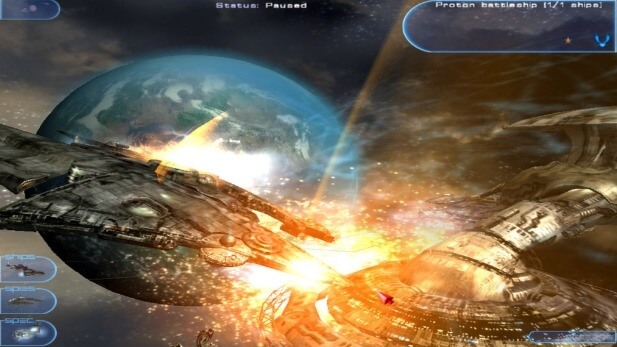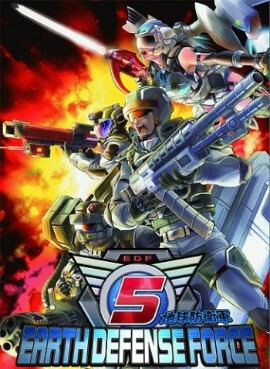The Mars campaign begins with intercepting trade ships which are supplying Earth's installations. Following this mission are some other missions which contain fights on the outer regions of Sol, between colonies of Mars and Earth. And at the end of this episode, you'll have to attack Earth. To do so, you must destroy all units around Earth. These consist of some fighter squads and two (indestructible) military bases. First off, you'll kill the fighter squads, then HQ comes in play and sends two kamikaze ships at the military bases. These you must protect by putting your forces between the line of fire from the military bases and the kamikaze ships. When that's done, you'll see a nice cinematic and finish the first episode of the Mars campaign!
Legions of Iron
Once the outcome of the war is decided, be it Earth or Mars, humanity unites under the new Unified Government and forms the Legions of Iron, its vanguard of expansion into the unknown, commanded by the player.
As the human race expands outward from Sol, mysteries are solved and new ones are created as they encounter new worlds and alien civilizations. The humans encounter a race called the Kariak and become embroiled in a war with them. The player discovers that the Kariak are being manipulated into fighting with humanity by another species named the Darzok. The Kariak then ally with humanity and they jointly defeat the Darzok, foiling their plan to annihilate both races.
Gameplay
Haegemonia allows the player to create a multi-system empire. At first, only the planets similar to Earth can be colonized. After advanced terraforming and colonization techniques are researched or stolen from enemies, almost any planet can be colonized and, eventually, terraformed into Gaia-class worlds (gas giants are uninhabitable).
There are several ways of getting money to fund planetary projects and space construction: tax colonies, steal money from enemies with spies, mine resource-rich asteroids, receive tribute from other races/factions, and other ways (e.g. aid from Earth).
Research system is based on research points (RPs) which are allocated at the beginning of each mission. Most of the time, that is the maximum for the mission; however, certain random events may also increase that amount. During the campaign, all researched technologies are transferred from mission to mission, and the player can choose a certain number of ships and heroes to bring along to the next mission.
The espionage system is also different from many other games. Spy ships can be constructed in the same manner as other ships, usually no more than 3 may be present at a time. Certain heroes excel at spying and are best placed in those ships. These ships are invisible on sensors and have no sensors of their own (to prevent unfair use as scouts). Instead, spy ships can be assigned mission to be performed on planets, ships, or stations. The higher the level of the spy ship and/or hero is, the more types of missions they may perform (they gain levels by spying). In some cases, a well-trained spy ship may be worth several battleships. Spies can also be used to detect and stop enemy spies. If a spy ship is detected (e.g. spy mission failure, detected by another spy), it becomes visible for a short time to all ships, allowing it to be attacked. Ship behaviors and spy missions can be set using right-click menus. The same is true for subsystem targeting, although it is limited to hull, engines, and weapons.
Energy weapons are split up into three groups: cannons (fighters only), turrets (anti-fighter, used on turret corvettes and heavy ships), and blasters (only energy weapon for orbital bombardment, used on blaster corvettes and heavy ships). Contrary to popular belief, ships equipped with turrets can bombard planets, just not as effectively. Weaponry also comes in four distinct forms:
Proton: orange, ball-shaped projectile, primarily used by human ships. Proton weapons are fairly accurate and fast-hitting. They have the ability to penetrate shields.
Ion: blue-white beam, reminiscent of the Ion Cannons from Homeworld. Ion weapons are mainly used on Kariak ships; they are instant-hitting and have a chance to temporarily disable shields.
Quantum: grey-purple cloud. These weapons are slow, compared to proton projectiles, however they have high, area-of-effect damage. Used by Darzoks.
Missile: the highest damaging weapons. They are very effective against slow targets and are the ultimate planetary bombardment weapons, possessing a very high kill-off. To counter this, they are ineffective against fighters and very vulnerable to ECM: fully researched, MK-2 ECM systems will cause up to 90% of incoming missiles to veer off-course, though more advanced warheads can resist ECM to some extent.
Planetary takeovers are accomplished by literally bombing a planet into submission, killing millions of people in the process (apparently the designers did not want to add planetary combat to the game, not even a simulated one). If the population is low to begin with, the planet will most likely become uninhabited and free to be colonized. Planetary bombardment, apparently, does not affect the planet's quality and besides, there's no way to affect a planet's quality negatively, unlike the expansion.

















